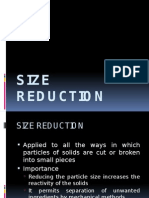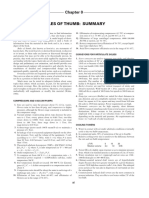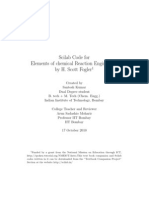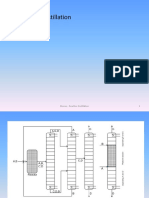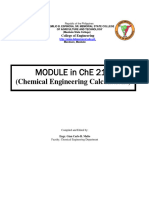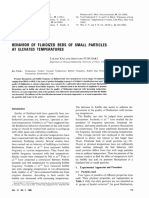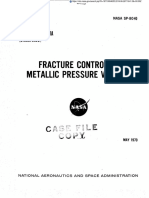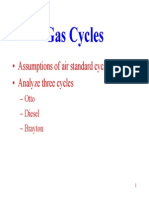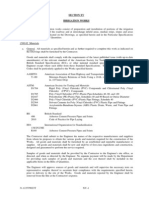0 ratings0% found this document useful (0 votes)
338 viewsKunii Levenspiel 1991
Kunii Levenspiel 1991
Uploaded by
papapa14The document presents a general equation to calculate the heat transfer coefficient (h) at wall surfaces of gas/solid contactors. The equation accounts for thermal properties of solids, particle size, gas properties, gas/solid system state (bubbling characteristics), and radiation transfer. The general equation reduces to simpler expressions for specific conditions like fine particles, large particles, low temperatures, fluidized beds, and fast fluidized beds. Prior equations from literature are discussed and shown to be special cases of the general equation proposed. Experimental data from previous studies is presented to support the equations.
Copyright:
© All Rights Reserved
Available Formats
Download as PDF, TXT or read online from Scribd
Kunii Levenspiel 1991
Kunii Levenspiel 1991
Uploaded by
papapa140 ratings0% found this document useful (0 votes)
338 views6 pagesThe document presents a general equation to calculate the heat transfer coefficient (h) at wall surfaces of gas/solid contactors. The equation accounts for thermal properties of solids, particle size, gas properties, gas/solid system state (bubbling characteristics), and radiation transfer. The general equation reduces to simpler expressions for specific conditions like fine particles, large particles, low temperatures, fluidized beds, and fast fluidized beds. Prior equations from literature are discussed and shown to be special cases of the general equation proposed. Experimental data from previous studies is presented to support the equations.
Copyright
© © All Rights Reserved
Available Formats
PDF, TXT or read online from Scribd
Share this document
Did you find this document useful?
Is this content inappropriate?
The document presents a general equation to calculate the heat transfer coefficient (h) at wall surfaces of gas/solid contactors. The equation accounts for thermal properties of solids, particle size, gas properties, gas/solid system state (bubbling characteristics), and radiation transfer. The general equation reduces to simpler expressions for specific conditions like fine particles, large particles, low temperatures, fluidized beds, and fast fluidized beds. Prior equations from literature are discussed and shown to be special cases of the general equation proposed. Experimental data from previous studies is presented to support the equations.
Copyright:
© All Rights Reserved
Available Formats
Download as PDF, TXT or read online from Scribd
Download as pdf or txt
0 ratings0% found this document useful (0 votes)
338 views6 pagesKunii Levenspiel 1991
Kunii Levenspiel 1991
Uploaded by
papapa14The document presents a general equation to calculate the heat transfer coefficient (h) at wall surfaces of gas/solid contactors. The equation accounts for thermal properties of solids, particle size, gas properties, gas/solid system state (bubbling characteristics), and radiation transfer. The general equation reduces to simpler expressions for specific conditions like fine particles, large particles, low temperatures, fluidized beds, and fast fluidized beds. Prior equations from literature are discussed and shown to be special cases of the general equation proposed. Experimental data from previous studies is presented to support the equations.
Copyright:
© All Rights Reserved
Available Formats
Download as PDF, TXT or read online from Scribd
Download as pdf or txt
You are on page 1of 6
At a glance
Powered by AI
The document discusses developing a general equation for heat transfer coefficient between surfaces and fluidized beds that accounts for various factors and can reduce to expressions for different regimes.
The document discusses heat transfer in fixed beds, incipiently fluidized beds, bubbling fluidized beds, the freeboard region, and fast fluidized beds.
The general equation accounts for the thermal properties of solids, particle size, gas properties, bed characteristics, and radiation transfer. It considers heat flow paths through gas and solid in parallel.
136
Ind. Eng. Chem. Res. 1991, 30, 136-141
Ltd.: Exeter, U.K., 1984; pp 95-105.
Lakin, W. D.; Van den Driessche, P. Time scales in population bi-
ology. SIAM J. Appl. Math. 1977,32,694-705.
Lasalle, J. P. Stability Theory for Ordinary Differential Equations.
J. Differ. Equations 1968, 4, 57-65.
Mc Carty, P. L. Anaerobic Waste Treatment Fundamentals. Public
Works 1964, Sept, 107-112; Oct, 123-126; Nov, 91-94; Dec, 95-99.
Mosey, F. E. Mathematical Modelling of the Anaerobic Digestion
Process: Regulatory Mechanisms for the Formation of Short-
chain Volatile Acids from Glucose. Water Sci. Techno!. 1983,15,
Pauss, A.; Beauchemin, C.; Samson, R.; Guiot, S. Continuous Mea-
surement of Dissolved H2 in Anaerobic Digestion Using a Com-
mercial Probe Hydrogen/Air Fuel Cell-based. Biotechno!. Bioeng.
Peiffer, K.; Rouche, N. Liapunovs Second Method Applied to Par-
209- 23 2.
1990, 35, 491-502.
tial Stability. J . MBc. 1969, 8 (2), 323-334.
Pomerleau, Y. Mod6lisation et contrBle dun procBdB fed-batch de
cultures des levures ti pain. Ph.D. Thesis, Ecole Polytechnique
de MontrBal, Canada, 1990.
Pomerleau, Y.; Perrier, M.; Dochain, D. Adaptive nonlinear control
of the Bakers yeast fed-batch fermentation. Proc. 1989 Am.
Control Conf. (Invited Session on Intelligent Systems and Ad-
vanced Control Strategies in Biotechnology), 1989,2,2424-2429.
Renard, P.; Dochain, D.; Bastin, G.; Naveau, H. P.; Nyns, E. J.
Adaptive Control of Anaerobic Digestion Processes. A Pilot-scale
Application. Biotechno!. Bioeng. 1988, 31, 287-294.
Taylor, D. G.; Kokotovic, P. V.; Marino, R.; Kanellapoulos, I.
Adaptive Regulation of Nonlinear Systems with Unmodelled Dy-
namics. IEEE Trans. Autom. Control 1989, 405-412.
Received for review February 2, 1990
Revised manuscript received July 2, 1990
Accepted July 24, 1990
A General Equation for the Heat-Transfer Coefficient at Wall Surfaces
of Gas/Solid Contactors
Daizo Kunii
Fukui Institute of Technology, 3-6-1 Gakuen, Fukui City, 910 Japan
Octave Levenspiel*
Chemical Engineering Department, Oregon St at e University, Coruallis, Oregon 97331 -2702
The general equation derived here accounts for the thermal properties of the solids, the particle
size, the properties of the gas, the state of the gas/solid system (bubbling characteristics), and the
contribution of radiation transfer. This equation reduces to a variety of simpler special case ex-
pressions: for fine particle and for large particle fluidized beds, for low-temperature operations,
at the surfaces immersed in both fluidized and moving beds, and for the tube wall surfaces of fast
fluidized beds. All these expressions are simple to use, and wepoint out where these expressions
have been tested against the reported experimental data.
The study of heat interchange between surfaces and
fluidized beds has a long history, and numerous expres-
sions have been proposed to represent the heat-transfer
coefficient in this situation. Reviews of these studies can
be found in Gelperin and Einstein (I), Botterill (2), Xavier
and Davidson (3), and Baskakov ( 4) .
In this paper, wepropose to develop a general equation
for h to encompass a broad spectrum of conditions and
operations. I t reduces to a number of special cases for
various contacting regimes, including the freeboard,
moving bed, and fast fluidization regimes.
Development of the General Equation
We start by considering heat transfer in fixed and in-
cipiently fluidized beds and then extend this analysis to
bubbling fluidized beds, to the freeboard region, and to
fast fluidized beds.
Within a Fixed Bed with Stagnant Gas. If heat flows
in parallel paths through the gas and the solid, then the
effective thermal conductivity of the fixed bed would be
given by
(1) k: =tm$g +(1 - emf)ks
Here, the superscript 0 refers to stagnant gas conditions,
and 4b =d,,,/d, represents the equivalent thickness of
stagnant gas film around the contact points between
particles, which aids in the transport of heat from particle
to particle. Since 4b depends on the bed voidage and since
weare interested in using eq 2 later in our fluidized bed
development, Figure 1 gives the values of 4b for the loosest
packing of a normal fixed bed, which is at about =0.476.
For most gas/solid systems, k, >>k,; thus, the last part
of the second term in eq 2 is smaller than unity. This
means that the thermal conductivity of a fixed bed is lower
than for the parallel path model of eq 1.
At the Wall of a Fixed Bed with Stagnant Gas.
Consider the wall region to extend a half particle diameter
out from the heat-exchange surface. Then, similar to eq
2, the thermal conductivity in this layer can berepresented
by
However, to account for the actual geometry and the small
Contact region between adjacent particles, Kunii and Smith
(5) developed the following modification to the parallel
path model:
where e , is the mean void fraction of this wall layer. Kunii
and Suzuki (6) derived the above equation and used it
successfully to represent the surface heat-transfer data
reported by workers at that time. They also explained why
a thickness of half a particle diameter was selected to
represent the wall region.
Figure 1 shows the calculated values for 4,, defined as
the equivalent thickness of stagnant film at a contact point
between a sphere and the wall surface. Note that the
r 1
(2)
0888-5885/91/2630-0136$02.50/0 0 1991 American Chemical Society
Ind. Eng. Chem. Res., Vol. 30, No. 1, 1991 137
k J k s
Figure 1. Ratio of effective thickness of gas film around a contact
point to particle diameter. &, for contact between adjacent particles,
& for contact between particle and surface; from Kunii and Smith
(5).
20
e-
s
+
II 10
s
0
gl ass, 1000 pm 'ps- 1.0
0 gl ass, 1000 pm 'ps- 0.78
A gl ass, 750 pm 'ps- 0.68
I I 1 I
Lines from eq 5 0
-
0 0.5 1 1.5
UoI Umf
Figure 2. Heat transfer between flat surfaces and stationary beds
of large particles, from Floris and Glicksman (7).
thickness of the equivalent stagnant gas layer is greater
for particle-wall contact than for particle-particle contact;
in addition, since e, >emf, these two factors indicate that
the wall layer presents a greater resistance to heat transfer
than an equivalent layer in the main body of the bed.
At this point, wemay define a heat-transfer coefficient
for this wall region of thickness d, / 2, and containing
stagnant gas, as follows:
(4)
At the Wall of a Fixed Bed with Flowing Gas.
Figure 2, reported by Floris and Glicksman (7), shows that
heat transfer in fixed beds is enhanced by gas flow through
the bed. This can be attributed to the lateral mixing of
gas in the void spaces at the surface with adjacent voids.
Yagi and Kunii (8) studied this phenomenon and came up
with the following two-term expression for ordinary fixed
beds, say dt / d, 1 10:
Nu =
hwdp
-- - (transfer for no gas flow) +
k,
(extra transfer because of gas flow)
Rearranging the expression gives
The lines on Figure 2 are drawn for a, =0.05, and the fit
to the data shows that this is a reasonable value for a, to
use in eq 5.
In an early study, Yagi and Kunii (8) analyzed the re-
ported data on h, for packed beds of larger solids, up to
12 mm in size, and found that CY, =0.041 well represented
those findings.
Time (s) Time (s)
Figure 3. Instantaneous h on a vertical dti =6.35 mm heater in a
d, =0.1 m fluidized bed; from Mickley and Fairbanks (9).
I
1000 2000 1000 10 20 40 100 200 400
Re,, =&
li
Figure 4. Correlation for h in large particle beds at low tempera-
ture, d, up to 4 mm, pressure up to 10 atm; data from Gl i ck" and
Decker (IO).
Bubbling Beds: Heat Transfer to Emulsion Pack-
ets. In a bubbling fluidized bed, rising bubbles sweep past
the heat-exchange surface, thereby washing away the
particles resting there and bringing fresh bed particles into
direct contact with the surface. Figure 3 indicates that the
contact time of these packets of emulsion particles with
the surface is of the order of 0.2-0.4 s for the conditions
of the experiments reported there. More generally, this
contact time depends on the experimental conditions. Let
us now consider heat transfer to these packets of particles.
Large Particles for Short Contact Times. Here the
particles are replaced before their mean temperature can
change appreciably, the temperature gradient takes place
only within the row of particles that is in direct contact
with the exchanger surface, and wecan ignore the thermal
diffusion into the rest of the emulsion packet.
Glicksman and Decker (IO) estimated the "heating" time
constant of particles resting on a surface. They found that
the temperature of particles larger than 1 mm did not
change appreciably for a residence time as long as 7 =1
s. Thus, this extreme can be used for these large particles.
Their experimental data combined with those reported by
several other groups are shown in Figure 4 for particles of
650-4000 pmat 1-10 bar. Curve fitting gives
hd,/(l - 6) =5.0 +0.05PrRep
k ,
(6)
Note the similarity in form with the expression for fixed
beds, eq 5.
Small Particles for Long Contact Times. Here the
particles near the surface closely approach the surface
temperature, the thermal transient is felt many layers from
the surface, and, hence, thermal diffusion into the emulsion
packet becomes the controlling resistance.
Botterill and Williams (I I ) solved the unsteady-state
heat conduction problem for the first layer of particles at
138 Ind. Eng. Chem. Res., Vol. 30, No. 1, 1991
the surface and found that 200-pm particles approach the
temperature of the surface in as little as 10 ms. In another
estimate of this extreme, Glicksman and Decker (10)
suggested that the temperature of the particles contacting
a surface changes substantially for particles smaller than
500 pmfor a contact time of about 1 s.
In a bubbling bed, the mean contact time of a packet
with the surface is related to the bubble frequency at the
surface and the fraction of time that packets contact the
surface by the expression
1 - 6,
7=-
n W
( 7)
Mickley and Fairbanks (9) analyzed this unsteady-state
conduction into the packets, giving an equation for the
local instantaneous heat-transfer coefficient. Assuming
that all packets of emulsion contact the surface for the
same length of time 7, given by eq 7, the time-averaged
heat-transfer coefficient between the packet and surface
was determined by Kunii and Levenspiel (12) to be given
by
I I. ,n
Bubbling Beds: h at a Heat-Exchanger Surface. At
this point, weare ready to develop the general expression
for the heat-transfer coefficient between a bubbling
fluidized bed and the exchanger surface. This expression
should account for the fact that part of the time the surface
is bathed by gas and part of the time by emulsion packets,
or
=hbubble at surface6w +hemulaion at surface(l - (9)
Now when the bubble is present at the surface, there
are two contributions to heat transfer: radiation and
convection. With the emissivities of bed solids and wall
given by e, and e,, the radiation coefficient becomes
5.67 X 10-8(T2 - 7'2)
hr = [ 53(lo)
(t +$ - l)(Ts - Tw)
The gas convection contribution when a bubble contacts
the surface is normally very small compared to the other
contributions to heat transfer. However, for fast fluidized
beds and in the freeboard above a dense bed where the
fraction of solids in not small, the convection term can
become important. Thus, wewrite, in general,
-
hbubbleat surface - hgas convection +hradiation (I1)
When the emulsion packet is present on the surface, we
have heat transfer in series-through the wall region of
thickness dp/2 followed by transfer through the emulsion
packet. In addition, through the wall region, wehave both
convection and radiation. These three terms sum to
- 1/ ( + 1
hemulaion at surface -
hat wall layer hthrough packet
1
Replacing eq 5 in eq 12 and eq 11 and 12 in eq 9 gives the
general expression for heat transfer at a surface
I I
1
(13)
emulsion at surface
where hpacket is given by eq 8, h, by eq 10, and kiw by eq
3.
Special Cases of the General Equation
For the Extreme of Fine Particles and High Tem-
perature. Here radiation between the emulsion packet
and the surface can be ignored because the particles at the
surface very quickly approach the surface temperature.
Also, gas flow through the emulsion is negligible (small
Re,). Finally, since the wall temperature reaches many
particle layers in the emulsion packet resting on the sur-
face, the additional resistance of the first surface layer can
be neglected. With these three simplifications, eq 13 re-
duces to
or
h =6,hr +1.13[k:ps(l - tmf)Cpsnw(l - 6w)]1/2 (14)
For the Extreme of Fine Particles and Low Tem-
perature. Here weignore radiation, so eq 14 reduces to
h =1.13[ktps(1 - tmf)Cpsnw(l - (15)
For the Extreme of Large Particles. Here transfer
through the emulsion packet can be ignored because the
temperature change only occurs in the first layer at the
surface. In bubbling beds, h, can also be ignored. For this
situation, eq 13 reduces to
or
h =hr +(1 - 6,)[2kEw/d, +0. 05Cpgpg~o]
(16)
Alternative Theoretical Approaches. A large num-
ber of models have been proposed to explain the mecha-
nism of heat transfer in fluidized beds (9,10,13-24). Some
are much too complicated to use for design calculations,
some only represent data in a narrow range of conditions,
and none are general enough to account for all the factors
considered in eq 13.
h between Moving Beds and Heat-Exchange Walls.
For gently descending emulsion solids, the residence time
of the emulsion in contact with the exchanger wall is very
long, the temperature boundary layer extends many par-
ticle layers into the bed, no bubbles are present, and ra-
diation can be neglected. In this situation, eq 13 reduces
to
(17)
1
h =
dp/2k;w +l/hpacket
where kZw is given by eq 3 and hpacket by eq 8.
Freeboard Region, Fast Fluidization, and Circu-
lating Solid Systems. Here a thin layer of fine particles
flows down along the container walls. Also, when hori-
Ind. Eng. Chem. Res., Vol. 30, No. 1, 1991 139
400
%
E 200
5
N
lr:
I '-A
0 I I I I I I I
0 200 400 600 800
d , (m)
Figure 5. Decay constant for freeboard agglomerates, for u, 1.25
m/s. (1) Chen et al. (26), (2) Bachovchin et al. (27), (3) Hoggen et
al. (28), (4) Walsh et al. (29), (5) Zhang et al. (30), (6) Nazemi et al.
(32), (7) Lewis et al. (32).
zontal tubes are present in the freeboard, clusters of
particles hit these now and then. This behavior results
in fairly high heat-transfer rates. Since the gas velocity
is high in these systems, the gas convection heat-transfer
coefficient may have to be considered; see the discussion
above eq 11. Also, the exchanger surfaces are bathed by
the lean phase most of the time; thus, 6 =1. With these
conditions, eq 13 becomes
h =hr +hg +(1 - 6w)hpecket (18)
and with eq 8 and 11,
h hr +h, +1.13[k'&,(l - c)C,,,n,(l - 6,)]'/2 (19)
Next, it is reasonable to assume that the rate at which
clumps of emulsion solids hit the tubes is related to the
upward flux Cup of solids at that level in the bed, or
(1 - a, ) , , G", (20)
Above a vigorously bubbling or turbulent fluidized bed,
the upward flux of solids into the freeboard falls off ex-
ponentially with height into the freeboard z, or
G,, a exp(-az) (21)
On the basis of reported data in these systems, Kunii and
Levenspiel (25) correlated the decay constant a with
particle size and gas velocity, as shown in Figure 5. For
fast fluidized beds, see ref 25 for estimates for a.
Combining the above three equations then gives the
heat-transfer coefficient at level z in terms of the coeffi-
cient at the bed surface, or
This expression, with a found from Figure 5, tells ap-
proximately how h should change with height in the
freeboard of a fluidized bed or in a fast fluidized bed.
Comparison of Prediction with Experiment
h on a Horizontal Tube Bundle in a Fine Particle
Bed. We tested the predictions of the above equations
1
Lines from eq 15
\
' 180"c } 82 pm sand
o i i 04c
I
h 135C - 57 Urn FCC catalyst
I
0
0 0.2 0.4
uo "S)
Figure 6. h on a horizontal tube bundle. Data from Beeby and
Potter (33); calculated lines from eq 15.
2000 1 I
I I
I
1
200 I I I
I I I
0.005 0.01 0.02 0.05 0.1 0.2 0.5
k, (W/m-K)
Figure 7. Effect of gas thermal conductivity on h,. Data from
Mickley and Fairbanks (9); see Martin ( 24) ; calculated lines from eq
15.
with the data of Beeby and Potter (33) because their bed
was not too small (0.305 X 0.305 m), fluidizing conditions
were well described, and two kinds of particles are used.
Values for h were calculated from eq 15 by using estimated
values of n, as follows:
FCC catalyst: d =57 pm, k, =0.20 W/ ( mK)
at 135 "C, n, (9-l) 2.0 3.1 3.4 3.5
u, (m/sf 0.05 0.1 0.2 0.35
sand: d, =82 pm, k, =1.2 W/(mK )
u, (m/s) 0.05 0.2 0.4
at 110 " C, n, (s-') 0.50 1.4 2.4
at 180 "C, n, (9-l) 0.83 1.9 3.0
The results of these calculations are presented in Figure
6 and show that the derived equation does account for the
observed maximum in h at some intermediate velocity.
For details of these calculations, see Example 13.1 in Kunii
and Levenspiel (34).
Effect of h on Gas Thermal Conductivity. For fine
particle systems, the data of Mickley and Fairbanks ( 9) ,
shown in Figure 3, is the best available for studying the
effect of gas thermal conductivity because a wide variety
of gases were tested in that study. Since particles were
fine and the temperature was not too high, eq 15 should
apply. From Figure 3, weestimate that n, =3 s-l and 6,
=0.2 for glass beads of k, =1.2 W/(m.K). Again in Figure
3, wesee that n, for the microspherical catalyst is roughly
double the value of n, for glass beads at the same flow
conditions. Thus, weselect n, =6 s-* and k, =0.2 W/
(m-K) for this case. With these values, eq 15 gives two lines
in Figure 7, accounting for the effect of thermal conduc-
tivity of gas. For more details, see Example 13.2 in ref 34.
140 Ind. Eng. Chem. Res., Vol. 30, No. 1, 1991
2ooJ 10 d, (Pn) 100 1 (mm) 10
(b)
Figure 8. Effect of particle size on h,,, from Martin (14). Data
from Baskakov (13), Wicke and Fetting (15), and Wunder and
Mersmann (35); dashed line calculated from eq 13.
For large particle systems, d, >1 mm, eq 16 should
apply. At not too high a temperature, eq 16 with 6 =6,
and 2kzw/k, =5 reduces to eq 6, and Figure 4 shows that
this expression fits the reported data.
Effect of Particle Size on h mar in Fluidized Beds.
Figure 8 summarizes the experimental data on h, versus
particle size as reported by Baskakov et al. (13), Wicke and
Fetting (15), and Wunder and Mersmann (35). At not too
high a temperature and for their gently bubbling beds, we
use the following estimates for our simple calculations: n,
=5 S-', 6, =0.1, u, a dk12, h,
Taking as a base point h,, =250 W/(m2-K) at d, =10
mm and inserting the known physical properties of the
systems studied allows us to evaluate the only unknown
term in eq 13, a,CPgpgu,. With this value, wecan then
determine how h,, changes with d,. The results of these
calculations are shown in Figure 8. Note that the particle
size at which h,,, becomes a minimum, d, =2 mm, is
correctly predicted by eq 13; see Example 13.3 in ref 34
for more details. Also note that for d I 20 pm eq 13 does
not predict the sharp drop in h, . dowever, this is where
the system enters the cohesive solids (Geldart C) regime,
with its very poor fluidization and low h values. These
equations do not apply in this regime.
h on Heat-Exchange Tubes in the Freeboard. Let
us see how well eq 22 fits the measured h values at surfaces
in the solids-lean freeboard above a dense bubbling
fluidized bed, as reported by Guigon et al. (36).
Start by taking h =350 W/(m2-K) at zf =0 and h =20
W/(m2.K) in the equivalent gas stream. These are rea-
sonable values. Next, even though Figure 5 is prepared
from data where u, I 1.25 m/s, let us assume that it can
be applied to Guigon's experiments at u, =2.4 m/s.
For d, =260 pm, Figure 5 gives au =1.5 s-l; thus, a =
1.5/2.4 =0.625 m-l, Inserting into eq 22 then gives
0.
-- - 2o - e- 0. 626~f / 2
350 - 20
The line in Figure 9 represents this equation and is seen
to approximately account for the decrease of h with height
in the freeboard.
Design Comments. To apply the above equations for
design, it is necessary to have good estimates of n, and 6 , ,
obtained from data such as shown in Figure 3, and for
_ -
400 I
I
I
I I
d, - 260 pm
300
?
m-
E
p 200
-
-r:
100
0
u o - 2.4 mls
-
-
0 L, =0.93 m from Eq. (22) -
L, =0.53 m
-
Figure 9. h on horizontal tube banks, dti =50 mm, immersed in a
1.19 X 0.79 m fast circulating fluidized bed. Data from Guigon et
al. (36); calculated line from eq 22.
fluidizing conditions close to the planned conditions. For
a review of such data, see Kunii and Levenspiel (34).
Nomenclature
a =decay content for solid density in the freeboard [m-'1
C, =specific heat [J /(kg.K)]
d,, =equivalent thickness of stagnant gas layer [m]
d, =diameter of a particle [m]
d, =inner diameter of bed [m]
dti =outer diameter of heat-exchange tube [m]
e =emissivity
G, =upward flux of clumps of solids in the freeboard
h =heat-transfer coefficient [W/(m2.K)]
k =thermal conductivity [ W/ ( mK) ]
n =bubble frequency at a point [s-l]
Nu =Nusselt number
Pr =Prandtl number
Re, =Reynolds number based on particle diameter and su-
u, =superficial velocity of gas passing through a fixed or
zf =distance into the freeboard or distance above the surface
Greek Symbols
a, =constant in eq 5
6 =bubble fraction in a fluidized bed
t =void fraction in a gas/solid system
emf =void fraction at minimum fluidization
M =viscosity of gas [kg/(ms)]
p =density [kg/m3]
T =contact time of a packet of particles at a surface [SI
4b, ?, =equivalent thickness of gas film, in terms of particle
diameter, between adjacent particles in the bed, and be-
tween particle and wall, respectively
=sphericity of solids
bsg/(m241
perficial gas velocity
fluidized bed [m/s]
of the bed [m]
Superscript
o =refers to stationary solids
Subscri pt s
e =effective
g =gas
r =radiation
Ind. Eng. Chem. Res. 1991,30, 141-145 141
s =solid
w =in wall region
Literature Cited
(1) Gelperin, N. I.; Einstein, V. G. In Fluidization; Davidson, J . F.,
Harrison, D., Eds.; Academic Press: Orlando, FL, 1971; p 471.
(2) Botterill, J . S. M. Fluid-Bed Heat Transfer; Academic Press:
Orlando, FL, 1975. Denloye, A. E.; Botterill, J . S. M. Powder
Technol. 1977, 19, 197.
(3) Xavier, A. M.; Davidson, J . F. In Fluidization, 2nd ed.; Davidson,
J . F., et al., Eds.; Academic Press: Orlando, FL, 1984; p 437.
(4) Baskakov, A. P. In Fluidization, 2nd ed.; Davidson, J . F., et al.,
Eds.; Academic Press: Orlando, FL, 1984; p 465.
(5) Kunii, D.; Smith, J . M. AIChE J. 1960,6, 71.
(6) Kunii, D.; Suzuki, M. Roc. 3rd Int. Heat Transfer Conf. Chicago
1966, 4, 344.
(7) Floris, F.; Glicksman, L. R. XVI ICHMT Symposium, Dubrov-
nik, Paper 2-2, 1984.
(8) Yagi, S.; Kunii, D. AIChE J. 1960, 6, 97; Int. Devel. Heat
Transfer, Boulder, Part IV, Paper 90, p 742, 1961.
(9) Mickley, H. S.; Fairbanks, C. A. AIChE J. 1955, 1, 374. Mickley,
H. S.; Fairbanks, D. F.; Hawthorn, R. D. Chem. Eng. Prog. Symp.
Ser. 1961, 57 (32), 51.
(10) Glicksman, L. R.; Decker, N. Heat Transfer in Fluidized Beds
of Large Particles. Report from Mech. Ena. Dept., MIT, Cam-
- -
bridge; MA, 1983.
(11) Botterill. J . S. M.: Williams. J . R. Trans. Inst. Chem. Ene. 1963.
~.
41, 217. Botterill,' J . S. M.;' et al. In Proc. Intern. Sykp. on
Fluidization; Drinkenburg, A. A. H., Ed.; Netherlands Univ.
Press: Amsterdam, 1967; p 442.
(12) Kunii, D.; Levenspiel, 0. Fluidization Engineering; J ohn Wiley:
New York, 1969.
(13) Baskakov, A. P.; et al. Powder Technol. 1973,8, 273; Fluidi-
zation and Its Applications; Cepadues: Toulouse, 1974; p 293.
(14) Martin, H. XVI ICHMT Symposium, Dubrovnik, Paper 2-5,
1984; Chem. Eng. Process. 1984, 18, 157, 199.
(15) Wicke, E.; Fetting, F. Chem.-Ing.-Tech. 1954, 26, 30.
(16) Goosens, W. R. A.; Hellinckx, L. Fluidization and its Appli-
cations; Capedues: Toulouse, 1974; p 303.
(17) Catipovic, N. M.; et al. In Fluidization; Grace, J . R., Matsen,
(18) Xavier, A. M.; et al. In Fluidization; Grace, J . R., Matsen, J.
(19) Levenspiel, 0.; Walton, J. S. Chem. Eng. hog. Symp. Ser. 1954,
(20) Martin, H. Chem. Eng. Commun. 1981, 13, 1.
(21) Bock, H. J .; Molerus, 0. German Chem. Eng. 1983,6,57. Bock,
H. J.; et al. German Chem. Eng. 1981, 4, 23; 1983, 6, 301.
(22) Chandran, R.; Chcn, J. C. AIChE J. 1985, 31, 244.
(23) Yoshida, K.; et al. Chem. Eng. Sci. 1974, 29, 77.
(24) Filtris, Y.; et al. Chem. Eng. Commun. 1988, 72, 189.
(25) Kunii, D.; Levenspiel, 0. Powder Technol. 1990,61, 193.
(26) Chen, G.; Sun, G.; Chen, G. T. In Fluidization V; 0stergaard,
K., Ssrensen, A., Eds.; Engineering Foundation: New York, 1986;
p 305.
(27) Bachovchin, D. V.; Beer, J . M.; Sarofim, A. F. Paper presented
at the AIChE Annual Meeting, Nov 1979; AIChE Symp. Ser.
1981, 77 (205), 76.
(28) Hoggen, B.; Lendstad, T.; Engh, T. A. In Fluidization V;
(astergaard, K., Ssrensen, A., Eds.; Engineering Foundation: New
York, 1986; p 297.
(29) Walsh, P. M.; Mayo, J . E.; Beer, J . M. AIChE Symp. Ser. 1984,
80 (234), 119.
(30) Zhang Qi; et al. Proc. CIESCIAIChE Joint Meeting; Chem.
Ind. Press: Beijing, 1982; p 374. In Fluidization '85, Science and
Technology; Kwauk, M., et al., eds.; Science Press: Beijing, 1985;
p 95.
(31) Nazemi, A.; Bergougnou, M. A.; Baker, C. G. J . AIChE Symp.
Ser. 1974, 70 (141), 98.
(32) Lewis, W. K.; Gilliland, E. R.; Lang, P. M. Chem. Eng. Prog.
Symp. Ser. 1962,58 (38), 65.
(33) Beeby, C.; Potter, 0. E. AIChE J. 1984, 30, 977.
(34) Kunii, D.; Levenspiel, 0. Fluidization Engineering, 2nd ed.;
(35) Wunder, R.; Mersmann, A. Chem.-Ing.-Tech. 1979,51,241.
(36) Guigon, P.; et al. Proc. Second Intern. Conf. Circulating
Received f or review J anuary 31, 1990
Accepted July 27, 1990
J . M., Eds.; Plenum: New York, 1980; p 225.
M., Eds.; Plenum: New York, 1980; p 209.
50 (9), 1.
Butterworth: Stoneham, MA, 1991.
Fluidized Beds; Compiegne: 1988; p 65.
Chemical Basis for Pyrochemical Reprocessing of Nuclear Fuel
John P. Ackerman
Chemical Technology Division, Argonne National Laboratory, 9700 S. Cass Avenue,
Argonne, Illinois 60439-4837
The integral fast reactor (I FR) is an advanced breeder reactor concept that includes on-site re-
processing of spent fuel and wastes. Spent metallic fuel from the I FR is separated from fission
products and cladding, and wastes are put into acceptable forms by use of a compact pyrochemical
process based on partition of fuel and wastes between molten salt and liquid metal. To minimize
reagent usage and, consequently, waste volume, electrotransport between metal phases is used
extensively for feed dissolution and product recovery, but chemical oxidation and reduction are
required for some operations. This paper describes the processes that are used and presents the
chemical theory that was developed for quantitatively predicting the results of both chemical and
electrotransport operations.
Introduction
On-site processing of spent metal fuel is a basic part of
the integral factor reactor (IFR) concept (Till and Chang,
1988, 1989; Burris et al., 1987). A pyrochemical process
to reclaim fuel is being developed and is expected to be
economically attractive for on-site use, to return essentially
all actinides to the reactor, and to result in a waste form
that can be stored on site but is expected to be well suited
to eventual permanent disposal. The fundamentally
thermodynamic theory used to predict the results of
chemical and electrotransport operations on which the
0888-5885/91/2630-0141$02.50/0
pyrochemical process is based was verified at the scale of
roughly 1 mol of plutonium (Tomczuk et al., 1991). This
paper presents that theory and then briefly describes its
application to pyrochemical reprocessing of IFR fuel.
Theory of Distribution of Elements
Pyrochemical processing is based on the partition of
elements between one or more metal phases (where they
exist as pure metals, as solutes in metal solution, or as
intermetallic compounds) and a molten salt phase (where
they are present as metal chlorides). At the processing
1991 American Chemical Society
You might also like
- San PHDDocument350 pagesSan PHDfabioalfaia8085No ratings yet
- CSTRDocument12 pagesCSTRsamueloNo ratings yet
- Reactors Design, Adiabatic and Non - Adiabatic ProcessesDocument30 pagesReactors Design, Adiabatic and Non - Adiabatic ProcessesRodrigo PicazoNo ratings yet
- Geldart - Gas Fluidization Technology PDFDocument238 pagesGeldart - Gas Fluidization Technology PDFKaique Castro100% (1)
- Design of Packed Bed Reactor Catalyst Based On Shape Size PDFDocument14 pagesDesign of Packed Bed Reactor Catalyst Based On Shape Size PDFArbaz AKNo ratings yet
- HTC Summary and Discussion of Chemical Mechanisms For Process EngineeringDocument18 pagesHTC Summary and Discussion of Chemical Mechanisms For Process EngineeringJoseCuevasMartinezNo ratings yet
- Kunii e Levenspiel (1997)Document12 pagesKunii e Levenspiel (1997)Elson Teti100% (1)
- RE II Group 2 Project Sept 2022-1Document34 pagesRE II Group 2 Project Sept 2022-1Lachyn SeidovaNo ratings yet
- Modeling and Simulation of Polymerization of Lactide To PolylacticDocument7 pagesModeling and Simulation of Polymerization of Lactide To Polylactickeyur1109No ratings yet
- Maxwell RelationsDocument5 pagesMaxwell RelationsRaghav AgrawalNo ratings yet
- Boundary LayerDocument8 pagesBoundary LayerVenkatarao ChukkaNo ratings yet
- Packed Bed ReactorDocument15 pagesPacked Bed ReactorBasil Thampi100% (1)
- Reaction Kinetics and Scale-Up of Catalytic ProcessesDocument6 pagesReaction Kinetics and Scale-Up of Catalytic Processessatishchemeng100% (1)
- Cheng 323 Chap 4Document82 pagesCheng 323 Chap 4Faisal Mumtaz100% (2)
- Size ReductionDocument16 pagesSize ReductionRA Memije100% (1)
- CO2 From Flue GasDocument49 pagesCO2 From Flue Gasjeffbush23No ratings yet
- Chemical Engineering in Practise 3: Fluidised BedsDocument12 pagesChemical Engineering in Practise 3: Fluidised BedsYaz Swedan100% (1)
- 0.-Rules of Thumb (Walas)Document7 pages0.-Rules of Thumb (Walas)Bryan PiguaveNo ratings yet
- Levenspiel Bischoff 1959Document4 pagesLevenspiel Bischoff 1959mauroogidoNo ratings yet
- FoglerDocument105 pagesFogleryvehuangNo ratings yet
- Vapor-Liquid Equilibria. Ethylene Oxide - Acetaldehyde and Ethylene Oxide - Water SystemsDocument5 pagesVapor-Liquid Equilibria. Ethylene Oxide - Acetaldehyde and Ethylene Oxide - Water SystemsGie0% (1)
- Fixed Bed ReactorsDocument4 pagesFixed Bed ReactorsAddison JuttieNo ratings yet
- CP302 MassTransfer 02 OKDocument38 pagesCP302 MassTransfer 02 OKDeneshVijayNo ratings yet
- Chemical Engineering Mass Transfer NotesDocument8 pagesChemical Engineering Mass Transfer NotesLebohang Czar NkuNo ratings yet
- Convective Mass TransferDocument13 pagesConvective Mass TransferAriadne ChuaNo ratings yet
- 8.3 - Packed-Bed ReactorsDocument20 pages8.3 - Packed-Bed Reactorscarolinacmleite0% (1)
- Isothermal ReactorDocument58 pagesIsothermal ReactorRoxanna Levine100% (1)
- Adsorption Sample ProblemsDocument5 pagesAdsorption Sample ProblemsAshish RanjanNo ratings yet
- Chapter 4 Reactor DesignDocument16 pagesChapter 4 Reactor DesignAli AhsanNo ratings yet
- Reactive DistillationDocument28 pagesReactive DistillationJacintoOrozcoSamuelNo ratings yet
- Sample Problem #20Document8 pagesSample Problem #20Dozdi100% (1)
- Batch Reactive DistillationDocument7 pagesBatch Reactive DistillationChalmer BelaroNo ratings yet
- The Problem Was 4 With The Same Assessment of Each Question and Please Answer Correctly in DetailDocument1 pageThe Problem Was 4 With The Same Assessment of Each Question and Please Answer Correctly in DetailArnia Putri PratamaNo ratings yet
- Topic 3.2 - Internal Diffusion and ReactionDocument36 pagesTopic 3.2 - Internal Diffusion and ReactionHamdan Azman100% (1)
- Chapter 2Document51 pagesChapter 2yungP100% (2)
- Trays and Packings Used in Distillation and Gas AbsorptionDocument12 pagesTrays and Packings Used in Distillation and Gas AbsorptionRhea Mamba100% (1)
- Fluidized-Bed Reactors 2012Document16 pagesFluidized-Bed Reactors 2012Davina NaidooNo ratings yet
- Distillation Tower DesignDocument65 pagesDistillation Tower DesignAntonio SilvaNo ratings yet
- ChE 211 Topic 2Document20 pagesChE 211 Topic 2Mikhoy RiveralNo ratings yet
- 3K4 2013 Assignment 2 SolutionsDocument9 pages3K4 2013 Assignment 2 SolutionsKhalil LasferNo ratings yet
- Lab Report Cstr-Intro Appa ProceDocument6 pagesLab Report Cstr-Intro Appa Procesolehah misniNo ratings yet
- Optimal Operation of A Semi-Batch Reactive Distillation Column (2000)Document7 pagesOptimal Operation of A Semi-Batch Reactive Distillation Column (2000)GodofredoNo ratings yet
- Liquid-Liquid Extraction Spray ColumnsDocument10 pagesLiquid-Liquid Extraction Spray Columnsalihamid hamediNo ratings yet
- Packed BedDocument3 pagesPacked BedNaveen KumarNo ratings yet
- Chemical Reactor Design - NotesDocument4 pagesChemical Reactor Design - NotesJanaki Devi ParratNo ratings yet
- 1-1 Unit (2016-2017)Document113 pages1-1 Unit (2016-2017)goutham100% (1)
- 05 Chapter 11 (Compiled)Document106 pages05 Chapter 11 (Compiled)Haziq KhairiNo ratings yet
- All ProblemsDocument29 pagesAll Problemsahmed hatemNo ratings yet
- Aspen Physical Property System PDFDocument342 pagesAspen Physical Property System PDFjdgh1986No ratings yet
- Riccardo Tesser, Vincenzo Russo - Advanced Reactor Modeling With MATLAB - Case Studies With Solved Examples-De Gruyter STEM (2020)Document300 pagesRiccardo Tesser, Vincenzo Russo - Advanced Reactor Modeling With MATLAB - Case Studies With Solved Examples-De Gruyter STEM (2020)Leonardo Almeida de CamposNo ratings yet
- Solution.: L and Width W. The Liquid Flows As A Falling Film With Negligible Rippling Under The Influence of Gravity. EndDocument4 pagesSolution.: L and Width W. The Liquid Flows As A Falling Film With Negligible Rippling Under The Influence of Gravity. EndChintiaNo ratings yet
- Question 2Document8 pagesQuestion 2mkbNo ratings yet
- Separation Processes HandoutDocument10 pagesSeparation Processes Handoutkiran367No ratings yet
- Bubble Column ReactorsDocument34 pagesBubble Column ReactorsGhaya Bani Rushaid100% (2)
- Hysys SimulationDocument24 pagesHysys SimulationNeybil100% (2)
- Chemical Reactor Design, Optimization, and ScaleupFrom EverandChemical Reactor Design, Optimization, and ScaleupRating: 5 out of 5 stars5/5 (1)
- Introductory Applications of Partial Differential Equations: With Emphasis on Wave Propagation and DiffusionFrom EverandIntroductory Applications of Partial Differential Equations: With Emphasis on Wave Propagation and DiffusionNo ratings yet
- Chemical Reactor Analysis and Applications for the Practicing EngineerFrom EverandChemical Reactor Analysis and Applications for the Practicing EngineerNo ratings yet
- Distillation Design and Control Using Aspen SimulationFrom EverandDistillation Design and Control Using Aspen SimulationRating: 5 out of 5 stars5/5 (2)
- Reactive Distillation Design and ControlFrom EverandReactive Distillation Design and ControlRating: 1 out of 5 stars1/5 (1)
- Behavior of Fluidized Beds of Small Particles at Elevated TemperaturesDocument6 pagesBehavior of Fluidized Beds of Small Particles at Elevated Temperaturespapapa14No ratings yet
- Behavior of Fluidized Beds of Small Particles at Elevated TemperaturesDocument6 pagesBehavior of Fluidized Beds of Small Particles at Elevated Temperaturespapapa14No ratings yet
- SAXENA Heat Transfer Horizontal Tube PDFDocument15 pagesSAXENA Heat Transfer Horizontal Tube PDFpapapa14No ratings yet
- Saxena Grewal Correlaciones para Minina Particulas Pequeñas PDFDocument6 pagesSaxena Grewal Correlaciones para Minina Particulas Pequeñas PDFpapapa14No ratings yet
- Fracture Control OF Metallic Pressure Vessels: Nasa Space Vehicle Design CriteriaDocument68 pagesFracture Control OF Metallic Pressure Vessels: Nasa Space Vehicle Design CriteriaStefano MilaniNo ratings yet
- Exam 1 Chemistry 112 October 7, 2013Document5 pagesExam 1 Chemistry 112 October 7, 2013Karren Ferrer-Mora HandayanNo ratings yet
- Thermowell InstallationDocument8 pagesThermowell Installationprasoon_eilNo ratings yet
- Hexam Mine Nickel Chloride SynthesisDocument4 pagesHexam Mine Nickel Chloride SynthesisHarshilGargNo ratings yet
- Facet Electronica 1Document191 pagesFacet Electronica 1Joaquin Platero Ryū100% (4)
- Superconductivity & Optical FibersDocument17 pagesSuperconductivity & Optical FibersMahesh Lohith K.SNo ratings yet
- Dual Gate BucketDocument8 pagesDual Gate BucketVigneswaran VigneshNo ratings yet
- GREEN PharmacognosyDocument14 pagesGREEN PharmacognosyZian NakiriNo ratings yet
- 10 Grandgrout EPX100Document2 pages10 Grandgrout EPX100peter sandejasNo ratings yet
- Ion Exchange ChromatographyDocument4 pagesIon Exchange Chromatographyviper121No ratings yet
- Che332 Lab 2 Total Suspended Solids AnalysisDocument3 pagesChe332 Lab 2 Total Suspended Solids AnalysismasyitahNo ratings yet
- ASTM-D-3359 Tape Adhesive TestDocument8 pagesASTM-D-3359 Tape Adhesive TestlakshmananNo ratings yet
- Potato Cold Storage Load Calculations PDFDocument3 pagesPotato Cold Storage Load Calculations PDFShort Term CourseNo ratings yet
- VTU - V & VIIIsem Syllabus 23-7-8Document11 pagesVTU - V & VIIIsem Syllabus 23-7-8manjunatha tNo ratings yet
- Chemicals Zetag MSDS LDP Magnafloc 110 L - 0710Document7 pagesChemicals Zetag MSDS LDP Magnafloc 110 L - 0710PromagEnviro.comNo ratings yet
- Gas Cycles Otto, Diesel, Dual CyclesDocument43 pagesGas Cycles Otto, Diesel, Dual Cyclesprasad5034100% (1)
- Ducts For Irrigation WorkADM SpecficationDocument3 pagesDucts For Irrigation WorkADM Specficationbuddy1971No ratings yet
- MPM Table of Reaction For Chemistry Sem 3Document4 pagesMPM Table of Reaction For Chemistry Sem 3STPMBAHARUNo ratings yet
- Psychrometric Chart FundamentalsDocument18 pagesPsychrometric Chart FundamentalsAlvaro BenattiNo ratings yet
- Advanced Higher Biology TestDocument46 pagesAdvanced Higher Biology TestcacaNo ratings yet
- Storage Tank Design: Email:moemen - Hussein@alexu - Edu.egDocument58 pagesStorage Tank Design: Email:moemen - Hussein@alexu - Edu.egahmadhatakeNo ratings yet
- Climate Change Ozone Depletion and Air PollutionDocument430 pagesClimate Change Ozone Depletion and Air PollutionnghiasipraNo ratings yet
- Spe 76-048 Sep 2012Document10 pagesSpe 76-048 Sep 2012akashdruva892No ratings yet
- GulfSea Hydraulic HVI Plus Series PDFDocument2 pagesGulfSea Hydraulic HVI Plus Series PDFObydur RahmanNo ratings yet
- Kidde Engineered Fire Suppression System: 3-Inch Discharge ValveDocument2 pagesKidde Engineered Fire Suppression System: 3-Inch Discharge ValveEDUARDONo ratings yet
- Awwa-C210-15 - Pintura Tubulações PDFDocument56 pagesAwwa-C210-15 - Pintura Tubulações PDFmasmello2011No ratings yet
- DNA Extraction (Using The Omega Biotek E.Z.N.A. Mollusc DNA Kit)Document3 pagesDNA Extraction (Using The Omega Biotek E.Z.N.A. Mollusc DNA Kit)xicoalexandreNo ratings yet
- The Solar System SHSDocument28 pagesThe Solar System SHSCahliem2 SupanNo ratings yet
- Tutorial 3Document4 pagesTutorial 3Deepak Kumar SinghNo ratings yet
- 05 DD Issue3Document24 pages05 DD Issue3Tuấn HoàngNo ratings yet














